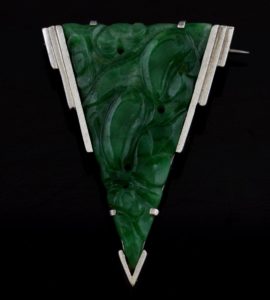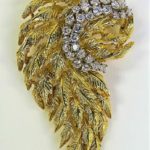
An Art Deco Jade Brooch, carved jade in a triangular shape, mounted in white metal tested as 14 ct, pin stamped 18 ct. Length 3.5 x 2.5 cm
Sold for £320 at Ewbank’s
Art Deco – a term coined in the 1960s – isn’t one style, but a pastiche of different styles, sources and influences. Art Deco designers borrowed from historic European movements, as well as contemporary Avant Garde art, the Russian ballets, folk art, exotic and ancient cultures, and the urban imagery of the machine age. Reference Victoria & Albert Museum.
From its outset, Art Deco was influenced by the bold geometric forms of Cubism; the bright colors of Fauvism and of the Ballets Russes; the updated craftsmanship of the furniture of the eras of Louis Philippe and Louis XVI; and the exotic styles of China and Japan, India, Persia, ancient Egypt and Maya art. It featured rare and expensive materials, such as ebony and ivory, and exquisite craftsmanship. The Chrysler Building and other skyscrapers of New York built during the 1920s and 1930s are monuments of the Art Deco style.
Art Deco was associated with both luxury and modernity; it combined very expensive materials and exquisite craftsmanship put into modernistic forms. Nothing was cheap about Art Deco: pieces of furniture included ivory and silver inlays, and pieces of Art Deco jewellry combined diamonds with platinum, jade, and other precious materials. The style was used to decorate the first-class salons of ocean liners, deluxe trains, and skyscrapers. It was used around the world to decorate the great movie palaces of the late 1920s and 1930s. Later, after the Great Depression, the style changed and became more sober.


